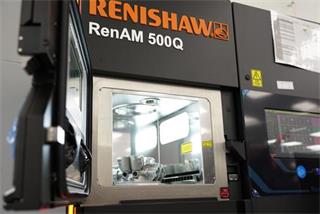Ta strona nie jest obecnie dostępna w Twoim języku. Możesz zapoznać się z tłumaczeniem automatycznym, korzystając z usługi Google Translate. Nie jesteśmy odpowiedzialni za świadczenie tej usługi, ani też wyniki tłumaczenia nie były przez nas sprawdzane.
Jeżeli chciałbyś uzyskać więcej pomocy skontaktuj się z nami.
Discovering how AM can add value to your manufacturing
Author: Chay Allen, AM Customer Applications Manager, Renishaw
As metal additive manufacturing (AM) technology becomes more productive and affordable, adoption rates are increasing; the 2023 Wohlers report shows an overall worldwide growth in AM products and services of 18.3 per cent in 2022. While its versatility and design freedom makes AM an attractive manufacturing technique, knowing when to embrace this technology over traditional manufacturing methods is integral to return on investment.
Here Chay Allen, Additive Manufacturing Customer Applications Manager at global engineering technologies company, Renishaw, explains what manufacturers should consider when matching a manufacturing technique to their production environment.
Quality, cost, material compatibility, product complexity and production volume are just some of the factors that manufacturers consider when choosing a production technique for their product. If a technology improves productivity and quality in one application, manufacturers may want to maximise their investment by exploring how it could be used elsewhere.
This is particularly true of AM, where we've seen uses of the technology broadening. AM has transitioned from a technique applied for rapid prototyping to one used for high volume production, particularly due to reductions in cycle times and cost per part.
One size does not fit all
AM has clear advantages that we can see across manufacturing industries. Medical manufacturers have used AM to develop complex orthopaedic implants that integrate with bone, while heat transfer component manufacturers can now develop intricate lattice structures to improve heat transfer efficiency. In other industries where weight to cost ratio is integral, such as aerospace, engineers can optimise component design to develop strong yet lightweight parts, improving performance.
When manufacturers invest in a technology for one application, it may seem tempting to see if it can deliver benefits in other ways. For example, could additively manufacturing legacy parts reduce the need for stockpiling on site and reduce downtime if operational parts break down?
However, just like any manufacturing method, AM will not always provide the best solution to a specific manufacturing or design challenge. There are still some limitations to AM technology, particularly as the upfront cost of the equipment can be higher than many traditional manufacturing methods. In many cases, if a part is already being produced using subtractive methods, it makes sense to continue with this approach. To understand if AM is the best fit, engineers will assess the requirements of the application against AM technology.
Design considerations
To understand if an existing or new part should be additively manufactured, engineers must establish whether it is adaptable to the AM process. One key difference between subtractive and additive methods is the approach to design — while traditional methods focused on manufacturing-driven designs, AM encourages design-driven manufacturing.
Design for AM requires engineers to look more closely at the function of final parts so they can create an optimised design, which may involve using complex structures.
When developing a new part, AM enables design engineers to start from scratch, giving them the design freedom to create a part using geometries that deliver the best performance. In some cases, engineers can do the same with legacy parts, taking an existing design and seeing how it can be adapted and improved by lightweighting or by combining previously separate components.
If the part can be improved with AM, for example by lightweighting, consolidating parts or optimising the design, additively manufacturing the part can improve operations.
Which is best?
When deciding when to use AM, manufacturers will consider the requirements of the part and application for which it is intended. They'll also consider the value that designing for additive can offer the final component, such as an increase in performance or a reduction in cost.
As well as design, manufacturers can consider how timing may influence the production method. When manufacturers aren't sure of the final design, and want to test different geometries, AM allows for rapid prototyping of multiple design iterations, enabling engineers to evolve the design quickly. Alternatively, if manufacturers are working to shorter lead times, it may be faster to set up and produce multiple components on an AM system compared with processes with longer set up times, such as injection moulding.
For AM adoption to be successful, the technology should meet, or surpass, the quality and performance of parts produced using subtractive technology. In business cases where there are requirements for faster production of fully customised parts, AM allows for greater design freedom and flexible, fast production. By analysing the design requirements, cost-per-part and production needs, manufacturers can select the technology that best aligns with the goals of each production run, and continue to benefit from a range of technologies, including additive manufacturing.




